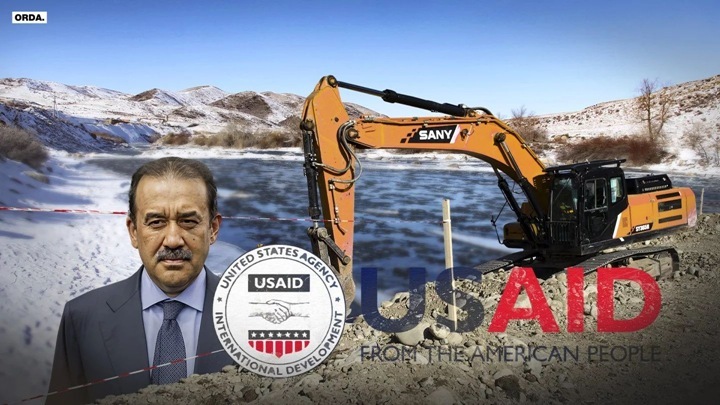Environmentalists are trying to stop the construction of the Rogun Dam
On April 10, President of the Republic of Tajikistan Emomali Rahmon received Antonella Bassani, Vice President of the World Bank (WB), and Anna Bjerde, Managing Director for Operations. Prospects for cooperation were discussed. On the eve of the Inspection Panel of the World Bank registered a complaint about the financing of the Rogun Dam in Tajikistan, which may cause damage to countries in the lower reaches of the Amu Darya. The cost of completion of the project, started in Soviet times, is $ 6.29 billion. Now funds for the Dam are coming from, among others, the World Bank. Since the resumption of the project in 2008, its cost has reached $ 12 billion.

The complaint was initiated by activists of Turkmenistan and Uzbekistan, countries located in the lower reaches of the Amu Darya River.
The notice of registration of the complaint states that the applicants preferred to remain anonymous for fear of possible persecution. They explained to the Inspection Panel that local organizations and activists in their countries could not represent their interests because of the risk of cross-border repression. It is noteworthy that about 60 thousand residents of Tajikistan, who will become internally displaced as a result of the construction of the Rogun reservoir, did not dare to join the complaint even anonymously. As a result, the applicants’ interests in communication with the Inspection Panel are represented by the Rivers without Boundaries Public Fund based in Almaty (Kazakhstan). Information support to applicants is provided by several environmental organizations — Bank Information Center (USA), International Rivers (USA) and CEE Bankwatch (Czech Republic).
The complaint alleges that the Rogun Dam project could cause serious socio-economic and environmental damage to countries downstream of the Vakhsh cascade of Dams in Tajikistan, including Turkmenistan and Uzbekistan. The applicants believe that the World Bank does not comply with its own social and environmental standards (ESF) and has not properly developed an Environmental and Social Management Plan (ESMP) and an Environmental and Social Commitment Plan (ESCP) for the Rogun Dam completion project. The World Bank’s mistakes and omissions in the design and implementation of the Rogun Dam construction project, according to the applicants, may lead to environmental damage and negative consequences for the environment, health and social sphere of the local population living downstream from the dam.
The authors of the complaint also point to the lack of meaningful public consultations and involvement of stakeholders in Turkmenistan and Uzbekistan. They claim that plans to fill the reservoir of the Rogun Dam (within 16 years) will lead to an annual reduction in the flow to the Amu Darya delta by at least 25%, which will cause a “progressive catastrophe” in the ecologically degraded region. The construction and operation of a giant reservoir capable of redistributing a significant part of water resources can lead to the extinction of fish species threatened with complete extinction (for example, unique Amu Darya pseudopathos) and the loss of tugai forests, including in the Tigrovaya Balka Nature Reserve, recognized in 2023 as a unique UNESCO World Heritage Site.
Of particular concern are the socio-economic consequences for 8-10 million people living in the lower reaches of the Amu Darya. Changes in runoff and deterioration of water quality will aggravate the problems of soil salinization, desertification, and reduced agricultural productivity, which will lead to a deterioration in public health, increased unemployment, poverty, and forced migration. The applicants claim that these problems are not considered at all in the socio-environmental assessment of the Rogun Dam project, presented on the World Bank website.
The complaint also notes that the environmental documents of the project were not available in Uzbek, Karakalpak and Turkmen languages, and there is also no information on contingency plans and damage compensation mechanisms in case of accidents.
“Registration of a complaint by the Inspection Panel is an important first step, giving hope that the voices of local communities from Uzbekistan and Turkmenistan who fear for their future and the environment will be heard internationally,” Alexander Kolotov, director of Rivers without Boundaries Public Fund, told Nezavisimaya Gazeta. “We represent the interests of these people who, due to the threat of cross–border persecution, cannot openly declare their problems, and we will seek a thorough investigation of all the facts and concerns set out in the statement.”
It is important to note that the ecological coalition “Rivers without Boundaries” already has a successful experience of interaction with the Inspection Panel of the World Bank. Earlier, representatives of the coalition and representatives of local communities filed a complaint about the financing by the World Bank of the MINIS project in Mongolia, which was supposed to build a dam on the tributaries of the Selenga River, which posed a threat to the ecosystem of Lake Baikal. After a thorough investigation by the Inspection Panel into this complaint, the MINIS project did not receive further funding, and the Mongolian Dams that threatened Lake Baikal were never built.
As for the current statement of environmentalists, the World Bank Inspection Panel, after conducting an initial inspection, found the complaint on the Rogun Dam to meet the eligibility criteria and registered it on April 8, 2025. The management of the World Bank must now provide an answer to the issues raised in the complaint by May 7, 2025. After receiving the response, the Inspection Panel will make a recommendation to the Board of Executive Directors of the Bank regarding the need for a full-scale investigation.
It is worth recalling that in 2010 the Inspection Panel had already received a complaint related to research on the Rogun Dam, but then did not recommend an investigation, since the World Bank pledged to finance additional activities to address the concerns of residents of the lower reaches of the Amu Darya basin. However, then the Inspection Panel emphasized the possibility of filing a new complaint if the World Bank decides to finance the construction of the Rogun Dam in the future.
Victoria Panfilova (Nezavisimaya Gazeta)


